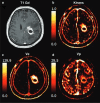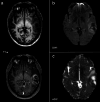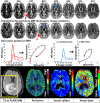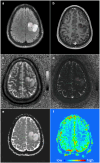Advanced MR Techniques for Preoperative Glioma Characterization: Part 1
- PMID: 36866773
- PMCID: PMC10946498
- DOI: 10.1002/jmri.28662
Advanced MR Techniques for Preoperative Glioma Characterization: Part 1
Erratum in
-
Erratum to "Advanced MR Techniques for Preoperative Glioma Characterization: Part 1".J Magn Reson Imaging. 2024 Apr;59(4):1467. doi: 10.1002/jmri.28933. Epub 2023 Aug 11. J Magn Reson Imaging. 2024. PMID: 37565507 Free PMC article. No abstract available.
Abstract
Preoperative clinical magnetic resonance imaging (MRI) protocols for gliomas, brain tumors with dismal outcomes due to their infiltrative properties, still rely on conventional structural MRI, which does not deliver information on tumor genotype and is limited in the delineation of diffuse gliomas. The GliMR COST action wants to raise awareness about the state of the art of advanced MRI techniques in gliomas and their possible clinical translation or lack thereof. This review describes current methods, limits, and applications of advanced MRI for the preoperative assessment of glioma, summarizing the level of clinical validation of different techniques. In this first part, we discuss dynamic susceptibility contrast and dynamic contrast-enhanced MRI, arterial spin labeling, diffusion-weighted MRI, vessel imaging, and magnetic resonance fingerprinting. The second part of this review addresses magnetic resonance spectroscopy, chemical exchange saturation transfer, susceptibility-weighted imaging, MRI-PET, MR elastography, and MR-based radiomics applications. Evidence Level: 3 Technical Efficacy: Stage 2.
Keywords: GliMR 2.0; brain; contrasts; glioma; level of clinical validation; preoperative.
© 2023 The Authors. Journal of Magnetic Resonance Imaging published by Wiley Periodicals LLC on behalf of International Society for Magnetic Resonance in Medicine.
Figures








References
-
- Miller KD, Ostrom QT, Kruchko C, et al. Brain and other central nervous system tumor statistics, 2021. CA Cancer J Clin 2021;71:381‐406. - PubMed
-
- Horbinski C, Berger T, Packer RJ, Wen PY. Clinical implications of the 2021 edition of the WHO classification of central nervous system tumours. Nat Rev Neurol 2022;18:515‐529. - PubMed
-
- Louis DN, Perry A, Reifenberger G, et al. The 2016 World Health Organization classification of tumors of the central nervous system: A summary. Acta Neuropathol 2016;131:803‐820. - PubMed
Publication types
MeSH terms
Grants and funding
LinkOut - more resources
Full Text Sources
Medical

